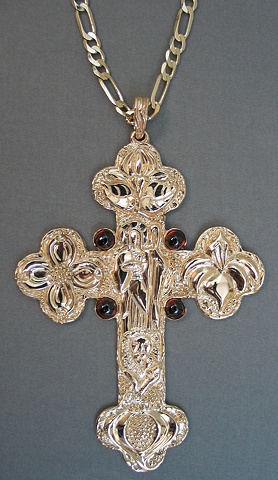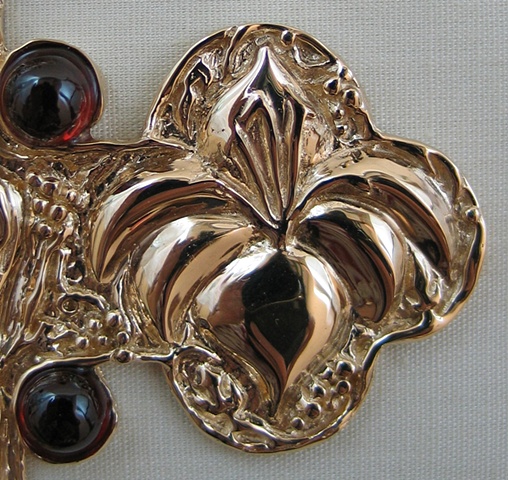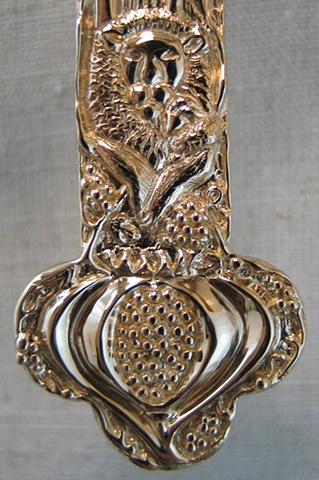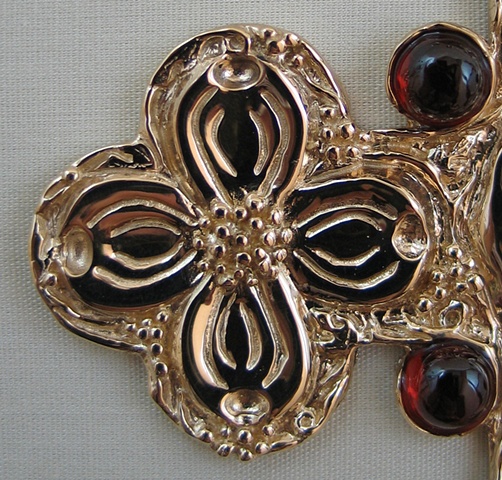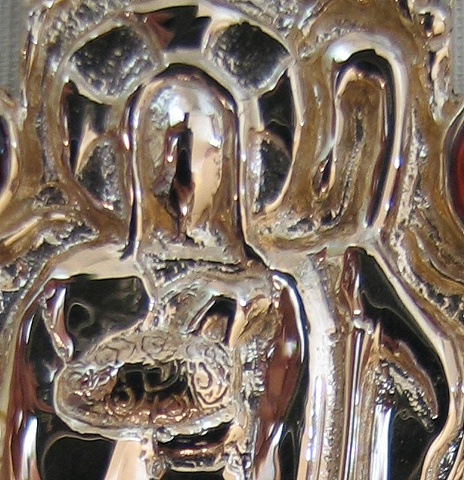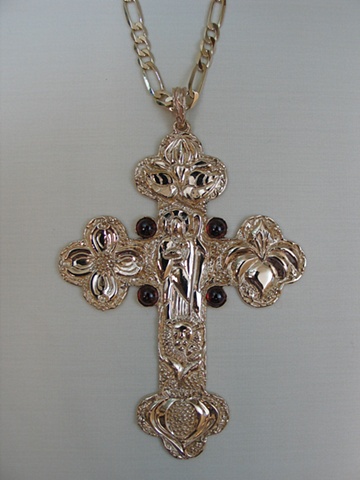COMPLETED PECTORAL CROSS
This gallery shows the finished cross with close ups of each design element with full symbolism of each.
Click each photo for the image details with symbolism.
The shape, known as a Budded or Apostle's Cross, features a Christ figure as the Good Shepherd bringing peace to his flock, as the lion and lamb lay together at his feet. Each trefoil features a botanical resurrection symbol, the lotus, lily, dogwood, and bursting pomegranate. The grapevines filling the form remind us that Christ is the Vine and we are the branches. The garnet gemstones placed in four corners symbolize the blood of Christ and remind us of our call to take the Gospel to the "corners of the earth".
LOTUS
The lotus seedling grows from the bottom of a pond sinking its roots deep into the mud, sending up a long stem through the murky water until it reaches through to the sunlight in a splendor of beauty. The lotus serves as a visual metaphor for the spiritual growth of the Christian who is to rise above the muck and sin reaching for the Light of the World. The lotus flower is historically associated with purity, redemption, rebirth, new life, and resurrection symbolism.
BURSTING POMEGRANATE
Because the thick, hard skin of a pomegranate bursts open exposing the juicy seeds, it became a symbol of the fullness of the suffering, resurrection, and power of our Lord, who burst forth alive from the tomb.
For more than 5,000 years, pomegranates have symbolized fruitfulness because of the numerous seeds in the fruit. It is one of the seven species brought back to Moses as proof of abundance in the land. It also represents the Church and unity, illustrated by the many seeds bound together in a single skin, suggesting the unity and oneness in Christ of the many believers. Its staining, deep blood red juice color has led to its use as a symbol of martyrs.
DOGWOOD
Dogwood blossoms have four petal-like bracts making the shape of a cross, the center of the flower resembles a crown of thorns, and the spots on each tip represent Christ's bloodstains. Legend tells us the dogwood tree used to be large and mighty like the oak so it was used as the wood for the cross. Since that time, the dogwood has never grown large enough to be used for that purpose again. The dogwood flower expresses new life, hope, and the resurrection. In the Diocese of Texas this flower holds special representation for us as a native tree that grows and blooms profusely in East Texas and at our beloved Camp Allen.
LILY
The lily is a symbol of resurrection and Easter. The bulb seems to decay in the ground, until it finally grows and blooms at Easter again, releasing new life from the seemingly dead bulb. The lily's other significance is taken largely from Jesus' allegory in his Sermon on the Mount, telling his disciples, "Consider the lilies of the field, how they grow: they neither toil nor spin; and yet I say to you that even Solomon in all his glory was not arrayed like one of these."
CHRIST THE TRUE VINE
The vine represents Christ who tells us in John 15, "I am the true vine, and My Father is the vinedresser...I am the vine, you are the branches." In referring to Himself as the stem that sustains the branches, and his Father as the vinedresser, He was using a metaphor that was well understood, since grape growing was widely practiced in the Holy Land. He describes how the vinedresser prunes so that it will bear more fruit and how a branch thrives in its connection with the stem and root system. The flowing grapevine was used in this design to entwine and connect the different design elements illustrating how Christ the Vine twines us together in a growing Christian community equipped to bear His fruit.
THE GOOD SHEPHERD
There are numerous biblical accounts using the analogy of Christ as The Good Shepherd. One of the most familiar is from the Gospel of John when Christ said, "I am the good shepherd; I know my sheep and my sheep know me". Christ as the Good Shepherd serves as a perfect pastoral life model for a bishop leading and unifying a flock.
THE LION AND LAMB
The familiar lion and lamb imagery has developed from a combination of biblical verses from Isaiah to symbolically convey a message of peace. The verses paint a picture of ferocious beasts (like the lion) feeding and lying with gentle animals (like the lamb). The depiction in the cross with a lion and lamb lying together at the feet of the Good Shepherd reminds us that peace and unity is available to us through our Great Mediator.
BUDDED OR APOSTLE'S CROSS
A cross with trefoil ends suggests budded flowers just before they bloom. The budded cross has come to symbolize the Christian on a journey of growth in faith, like budding flowers. The three foils on each end represent the Holy Trinity and the teaching of “Faith, Hope, Love; the Greatest of these is Love.” Another biblical interpretation is that the buds represent Aaron’s staff that budded and was preserved in the Arc of the Covenant, symbolizing life emerging from death or new life from difficult circumstances. The twelve total foils represent the twelve apostles so it is also referred to as the Apostle's Cross. This makes it an appropriate cross form for the episcopate as it reminds us of the unbroken succession of ordination extending back to the first twelve Apostles.
